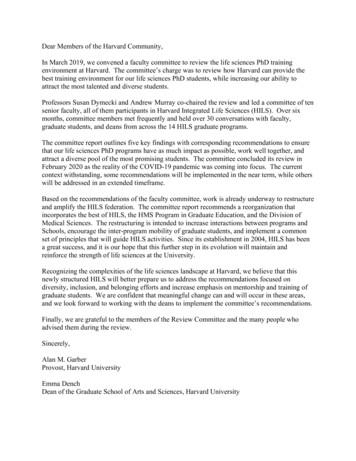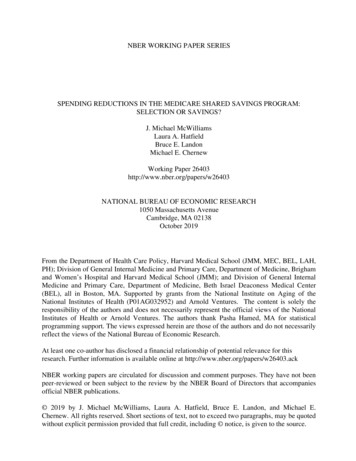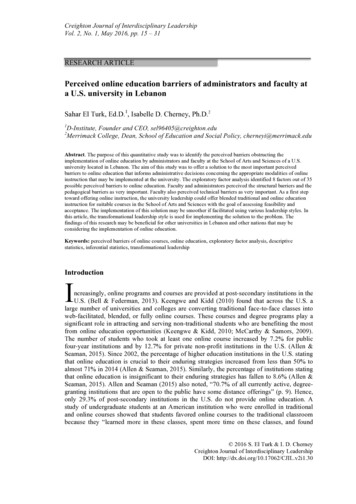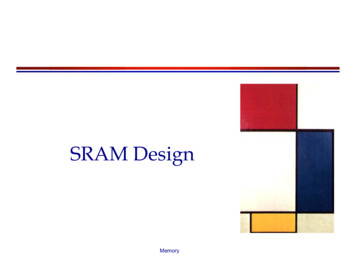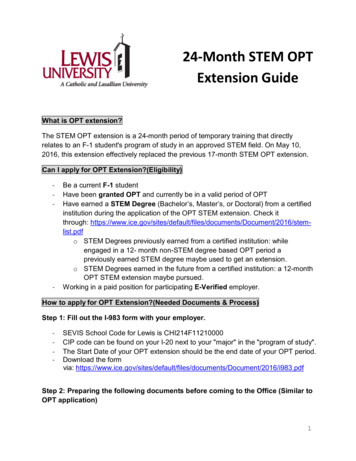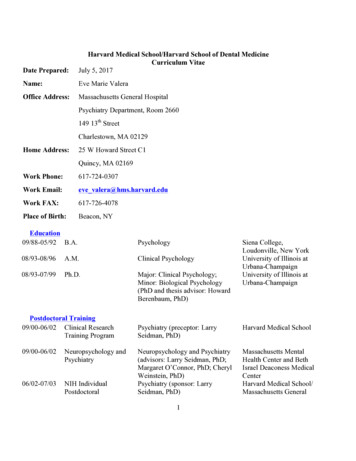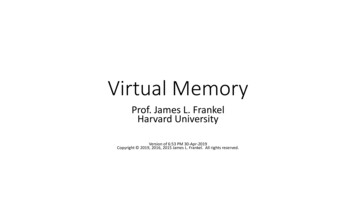
Transcription
Virtual MemoryProf. James L. FrankelHarvard UniversityVersion of 6:53 PM 30-Apr-2019Copyright 2019, 2016, 2015 James L. Frankel. All rights reserved.
Relocation and Protection At time program is written, uncertain where program will beloaded in memory Therefore, address locations of variables and code cannot be absolute –enforce relocation Must ensure that a program does not access other processes’ memory –enforce protection Static vs. Dynamic Relocation Static Relocation Addresses are mapped from virtual to physical at the time a program is loaded intomemory Program and data cannot be moved once loaded into memory Registers and data memory may contain addresses of instructions and data Dynamic Relocation Addresses are mapped from virtual to physical at the time a program is running Program and data can be moved in physical memory after being loaded
Base and Limit Registers The base register value is added to user’s virtual addressto map to a physical address – Relocation Virtual addresses greater than the limit register value isan erroneous memory address – Protection Allows only a single segment per process Does not allow a program to use more virtual addressspace than there is physical memory
Approaches to Virtual Memory (VM) Under user control – overlays VM uses fixed size pages Where is the instruction/data referred to by an address? Some pages in memory Some pages on disk When a page is accessed that is not in memory, that causes a pagefault Each process has its own page table – because each process has itsown address space
Virtual Memory – Address TranslationThe location and function of the MMU
Memory Management Unit (MMU) Translates Virtual addresses (VA) for program and data memory into Physical addresses (PA) for memory and I/O devicesVirtual AddressMMUPhysical Address
Page Table FunctionThe mapping fromvirtual memory addressesto physical memory addressesis given by the page table
Components of Addresses High-order bits of VA, the page number, used to index into the pagetable Low-order bits of VA, the offset, used to index within the page High-order bits of the PA is called the page frame number Low-order bits of the PA, the offset, is passed unaltered from the VA
Single-Level Page TableInternal operation of an MMU with sixteen 4 KB pages andwith eight 4 KB page frames
Two-Level Page TableSecond-level page tablesTop-levelpage table 32 bit address with 2 page table fields Two-level page tables
Advantages of Two-Level Page Table (1 of 2) It does not use less memory for the page table if all virtual addressspace is utilized However, because the page table is allocated in chunks, if onlyportions of the virtual address space is utilized, significant savingsmay be garnered For example, imagine a 32-bit virtual address with 4K byte pages on abyte-addressable computer In a single-level page table, the page table has 220 or 1,048,576 (1M) PTEs Gives the program a virtual address space of 232 bytes or 4G bytes Assuming each PTE is four bytes, that’s 4M bytes just for the page table
Advantages of Two-Level Page Table (2 of 2) Continuing with the assumptions of a 32-bit virtual address with 4Kbyte pages on a byte-addressable computer In a two-level page table 10 bits for the top-level table and 10 bits for the second-level tables Assume there are four virtual address spaces used of 222 bytes each Gives the program a virtual address space of 4 * 222 bytes or 16M bytes Requires four second-level page tables to be allocated The five page tables (i.e., the top-level page table and the four second-level page tables)have 5 * 210 entries Assuming each PTE and each pointer to a PTE is four bytes, that’s 5 * 210 * 4 bytes or 20Kbytes for all the page tables
Page Table Entry (PTE)Typical page table entry
PTE Fields Present/Absent Is this page in memory or on disk Protection Who can access this page and how Read, write, and execute access Modified Has the data in the page been changed since it was loaded Referenced Has the data in the page been accessed since it was loaded Caching Disabled Is the data in the page allowed to be cached
Number of Memory Accesses The page tables reside in memory! For each instruction that accesses only registers One access is required to read the PTE for the instruction address (assuming a single-levelpage table) One access is required to read the instruction For each instruction that accesses one data field in memory One access is required to read the PTE for the instruction address (assuming a single-levelpage table) One access is required to read the instruction One access is required to read the PTE for the data address (assuming a single-level pagetable) One access is required to read the data word And so forth for instructions that access more than one data field (if they exist) How can we reduce the number of memory accesses?
TLBs – Translation Lookaside BufferA TLB is a cache for the page table. The TLB speedsup address translation from virtual to physical.
TLB Function The TLB is implemented using a CAM (Content-Addressable Memory)– also known of as an Associative Memory TLB faults can be handled by hardware or by software through afaulting mechanism (happens on SPARC, MIPS, HP PA)
Simplified TLB SchematicVirtual AddressPage NumberOffsetPage NumberPage FrameNumberPage NumberPage FrameNumberPage NumberPage FrameNumberPage NumberPage FrameNumber Page FrameNumberTLBHitOffsetPhysical Address
Additional TLB Data In order for the TLB to act fully as a cache for the page table, it needsto contain additional data associated with each page number The other fields in the PTE need to be present in the TLB Present/AbsentProtectionModifiedReferencedCaching Disabled
Powers of Two 210 is 1K (Kilo) 220 is 1M (Mega) 230 is 1G (Giga) 240 is 1T (Tera) 250 is 1P (Peta) 260 is 1E (Exa) 270 is 1Y (Yotta)
Large 64-bit Address Space 12-bit offset (address per page) 52-bit page number given to the MMU Page Size 12-bits implies 4K bytes/page for a byte addressable architecture Size of page table if all VAs are used 252 or 4P PTEs That’s too many! Of course, we don’t have that much disk space either, but We need an alternate way to map memory when address spaces get large
Inverted Page Table Organize Inverted Page Table by PAs rather than by VAs One PTE per page frame – rather than per virtual page However, now there is a need to search through the inverted pagetable for the virtual page number! Obviously, this is very, very slow Many memory accesses per instruction or data access We rely on a large TLB to reduce the number of searches The inverted page table is often organized as a bucket hash table Reduces the time to linearly search within a bucket
Inverted Page Table ComparisonComparison of a traditional page table with an inverted page table
I-Space and D-Space Virtual memory and page tables are often split into Instruction and DataSpaces Can enhance the performance of both caches and page tables Both I- and D-Spaces that are currently being used should be mapped intomemory We don’t want accesses to data to cause program memory to be swapped out Behavior of I-Space More sequential access More locality of reference Loops Functions calling functions Execute (read) only
Page Fault and Page Replacement Algorithms Page fault forces choice Determine which page must be removed Make room for incoming page Modified page must first be saved Unmodified page is just overwritten Pages with code are never modified Accessed page must be read into memory Page table must be updated Better not to choose an often used page Will probably need to be brought back in soon
Optimal Page Replacement Algorithm Replace page needed at the farthest point in future Optimal but unrealizable Estimate future reference pattern Log page use on previous runs of process Probably not reproducible Impractical Gives us a goal to attempt to attain
Not Recently Used (NRU) Page Replacement Algorithm Each PTE has Referenced & Modified bits Pages are classified Both are cleared when pages are loadedAppropriate bit(s) set when page is referenced (reador written) and/or modifiedPeriodically, the R bit is clearedClass 0: Not referenced, not modifiedClass 1: Not referenced, modifiedClass 2: Referenced, not modifiedClass 3: Referenced, modifiedNRU removes page from lowest class at random
First-In, First-Out (FIFO) Page ReplacementAlgorithm Maintain a list of all pages Ordered by when they came into memory: most recent at thetail and the least recent at the head On page fault, page at head of list is replaced Disadvantage Page in memory the longest may be used frequently
Second-Chance Page Replacement Algorithm Operation of a second chance Pages sorted in FIFO orderR bit inspected before replacing the oldest pageIf R bit is set, the page is put at the tail of the list and the R bit is clearedIllustration above shows page list if fault occurs at time 20, and page A has its R bit set(the numbers above the pages are loading times)
The Clock Page Replacement Algorithm
Least Recently Used (LRU) Page ReplacementAlgorithm Good Approximation to Optimal Assume pages used recently will used again soon Throw out page that has been unused for longest time Might keep a list of pages Most recently used at front, least recently used at rear Must update this list on every memory reference! Alternatively, maintain a 64-bit instruction count Counter incremented after each instruction Current counter value stored in PTE for page referenced Choose page whose PTE has the lowest counter value Still requires a time-consuming search for lowest value
LRU in Hardware using an n-by-n Bit Matrix (1 of 2) Start with all bits set to zero When page frame k is accessed– Set bits in row k to 1– Clear bits in column k to 0 The row with lowest binary value is the LRU– The row with the next lowest binary value is the nextleast recently used– And so forth
LRU in Hardware using an n-by-n Bit Matrix (2 of 2)LRU using bit matrix – reference string is:0, 1, 2, 3, 2, 1, 0, 3, 2, 3
Not Frequently Used (NFU) Page Replacement Algorithm (1 of 2) A simulation of LRU in SoftwareAssociate a counter with each pageInitialize all counters to zeroOn occasional clock interrupts, examine the R bit foreach page in memory Add one to the counter for a page if its R bit is set Choose page with lowest counter value forreplacement Problem: frequently accessed pages continue to havelarge values – i.e., counters are never reset Possible Fix: (1) Shift all counters right on clock interruptthen (2) Set MSB if R bit is set This is one implementation of Aging
Not Frequently Used (NFU) Page Replacement Algorithm (2 of 2)00010000 The aging algorithm simulates LRU in software
The Working Set Page Replacement Algorithm (1 of 2)k The working set is the set of pages used by the k most recent memory references w(k, t) is the size of the working set at time, t
The Working Set Page Replacement Algorithm (2 of 2)The working set algorithm
The WSClock Page Replacement Algorithm (1 of 2) Circular list of page frames – Initially empty Associate a time of last use, R bit, and M bit witheach page On page fault, examine the R bit for page pointedto by clock hand– If its R bit is set, clear the R bit and move hand to next page– If its R bit is clear, and if its age is less than or equal to τ, advancethe hand– If its R bit is clear, and if its age is greater than τ and it is notmodified, replace that page– If its R bit is clear, and if its age is greater than τ and it is modified,schedule a write of that page to disk and advance the hand andexamine the next page
The WSClock Page Replacement Algorithm (2 of 2)Operation of the WSClock algorithm
Review of Page Replacement Algorithms
Registers and data memory may contain addresses of instructions and data Dynamic Relocation Addresses are mapped from virtual to physical at the time a program is running Program and data can be moved in physical memory after being loaded. Base and Limit Registers The base register value is added to user's virtual address to map to a physical address -Relocation Virtual .

